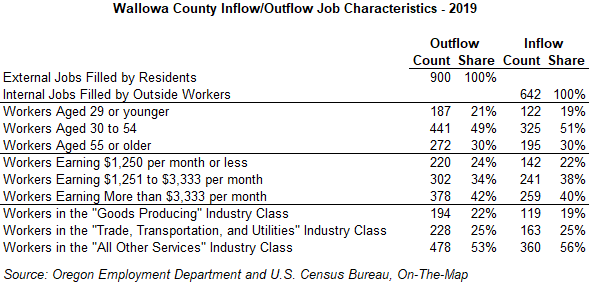Head Out on the Highway: Wallowa County Commuter Data - 2019
February 25, 2022 The thought of commuting to work may conjure images of the Westside’s urban sprawl and life in the big city; however, living in one town and working in another is common among Oregon’s rural workforce as well. The U.S. Census Bureau provides data on workforce commute patterns with its On-The-Map tool. The most recent data reveals that just under one-fourth of Wallowa County’s workforce came from outside the county in 2019 while close to one-third of workers living in Wallowa commuted to jobs in a different county.As might be expected, it’s common for workers to commute to or from neighboring counties. Roughly 44% of Wallowa County’s inbound commuters came from Baker, Umatilla, and Union counties in 2019. Union County held the top spot among the three, shipping 25.9% of inbound commuters. Union County supplied 6.2% of Wallowa’s total workforce (mostly from La Grande and Elgin). Umatilla County supplied 2.6% of Wallowa’s workforce (mostly from Pendleton and Hermiston). Baker County supplied 1.7% of the workforce (mostly from Baker City).
Baker, Umatilla, and Union counties served as the destination for 35% of Wallowa’s outbound commuters. Union held the top spot here as well, receiving 19.3% of outbound commuters. For workers who reside in Wallowa County, Union County supplied 5.9% of jobs, Umatilla County supplied 3.5% of jobs, and Baker County supplied 1.4% of jobs. Most of these jobs were in La Grande, Pendleton, Hermiston, and Baker City.
 Most Wallowa County commuters lived or worked beyond Baker, Umatilla, and Union counties in 2019. More than 68% of all commuters, however, lived or worked in Oregon. Multnomah, Clackamas, Klamath, and Lane counties were high on the list of where Wallowa commuters lived. Multnomah and Marion counties were high on the list of where commuters worked. Benton County, Washington, home to Richland and Kennewick was also high on the list of where commuters work, while Walla Walla, Washington was high on the list of where commuters live. Washington shipped 13.9% of Wallowa County commuters while receiving 16.1%. Idaho shipped 13.4% of Wallowa County commuters while receiving 7.0%.
Most Wallowa County commuters lived or worked beyond Baker, Umatilla, and Union counties in 2019. More than 68% of all commuters, however, lived or worked in Oregon. Multnomah, Clackamas, Klamath, and Lane counties were high on the list of where Wallowa commuters lived. Multnomah and Marion counties were high on the list of where commuters worked. Benton County, Washington, home to Richland and Kennewick was also high on the list of where commuters work, while Walla Walla, Washington was high on the list of where commuters live. Washington shipped 13.9% of Wallowa County commuters while receiving 16.1%. Idaho shipped 13.4% of Wallowa County commuters while receiving 7.0%.It may be difficult to imagine commuting more than one or two hours for work. For perspective, a Baker City to Joseph commute or a Pendleton to Joseph commute takes more than two hours. However, commuting is not limited to the arduous daily drive. While On-The-Map commute data doesn’t tell us how commutes occurred or how long commuters stayed for work, several scenarios are possible and likely. Commuters can be full or partial telecommuters, working for a firm outside their county of residence and infrequently making a physical commute. Home based call center employees and outside sales representatives are examples of occupations that fit this scenario. Commuters can commute for extended shifts, short stays, or even seasons, traveling to where the job demand is and returning home when the work is complete. Nurses and physicians are examples of extended shift or short stay occupations. Commuters with either of these occupations could work for a two or three day shift and then return home for three or four days. Forest fire fighters along with leisure and hospitality workers are examples of seasonal positions that require extended stays, but might not encourage year-round residence.
The accompanying table provides some additional points of interest. Wallowa County exports more workers than the county imports. The largest share of commuters leaving the county earned more than $3,333 a month. The largest share of commuters entering the county earned more than $3,333 a month, but this was a close race with those who earned between $1,251 and $3,333 a month. The largest share of commuters in either direction were 30 to 54 years old. On-The-Map can provide details not contained in this report or the table, so check out the data tool or drop me a line if you have any questions.